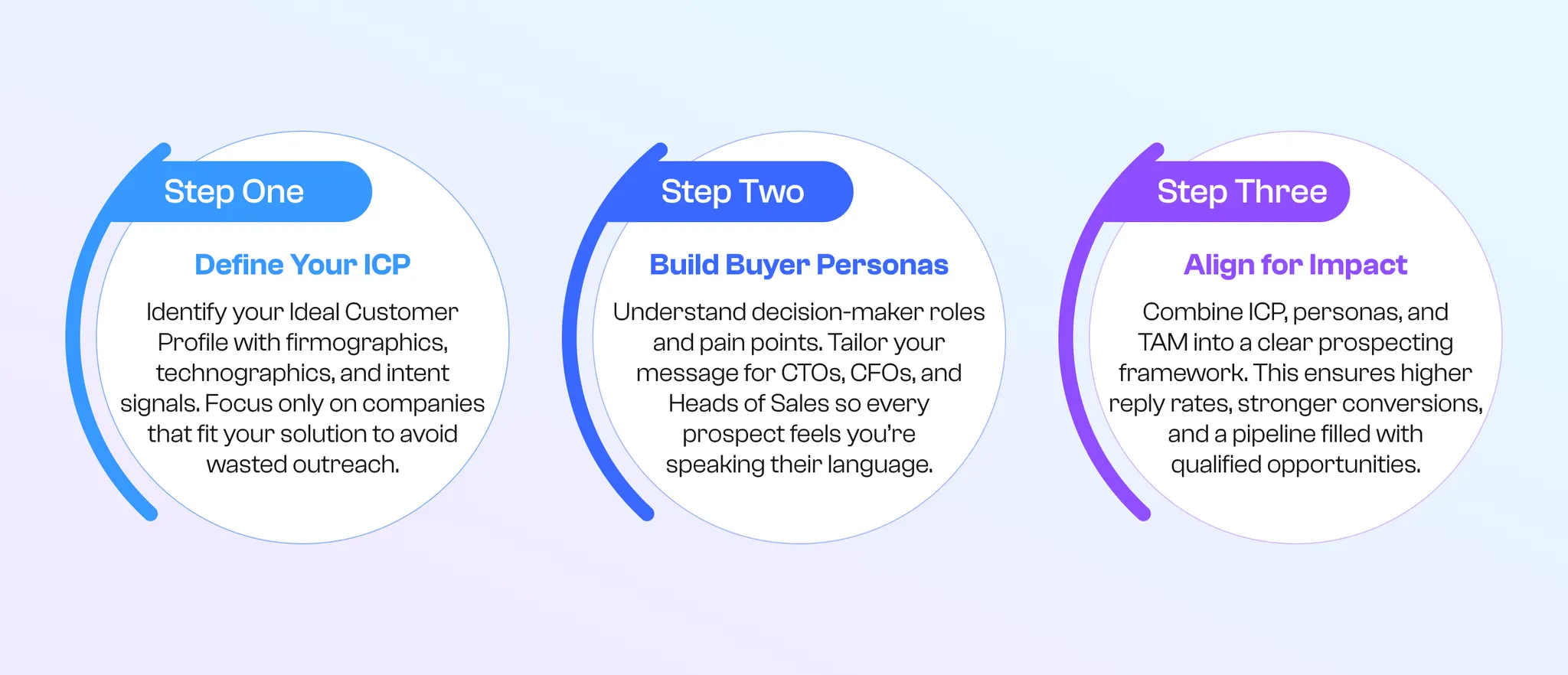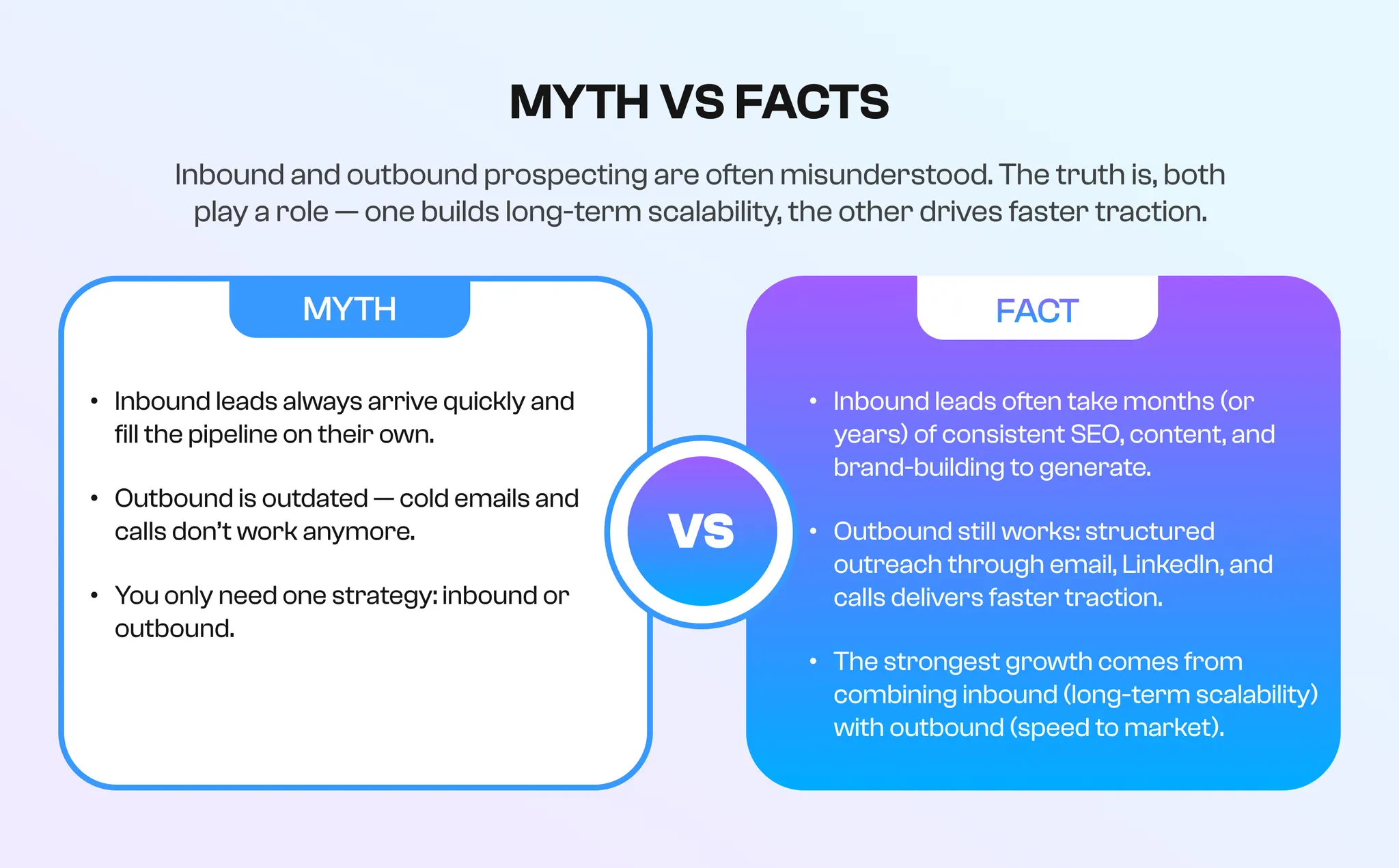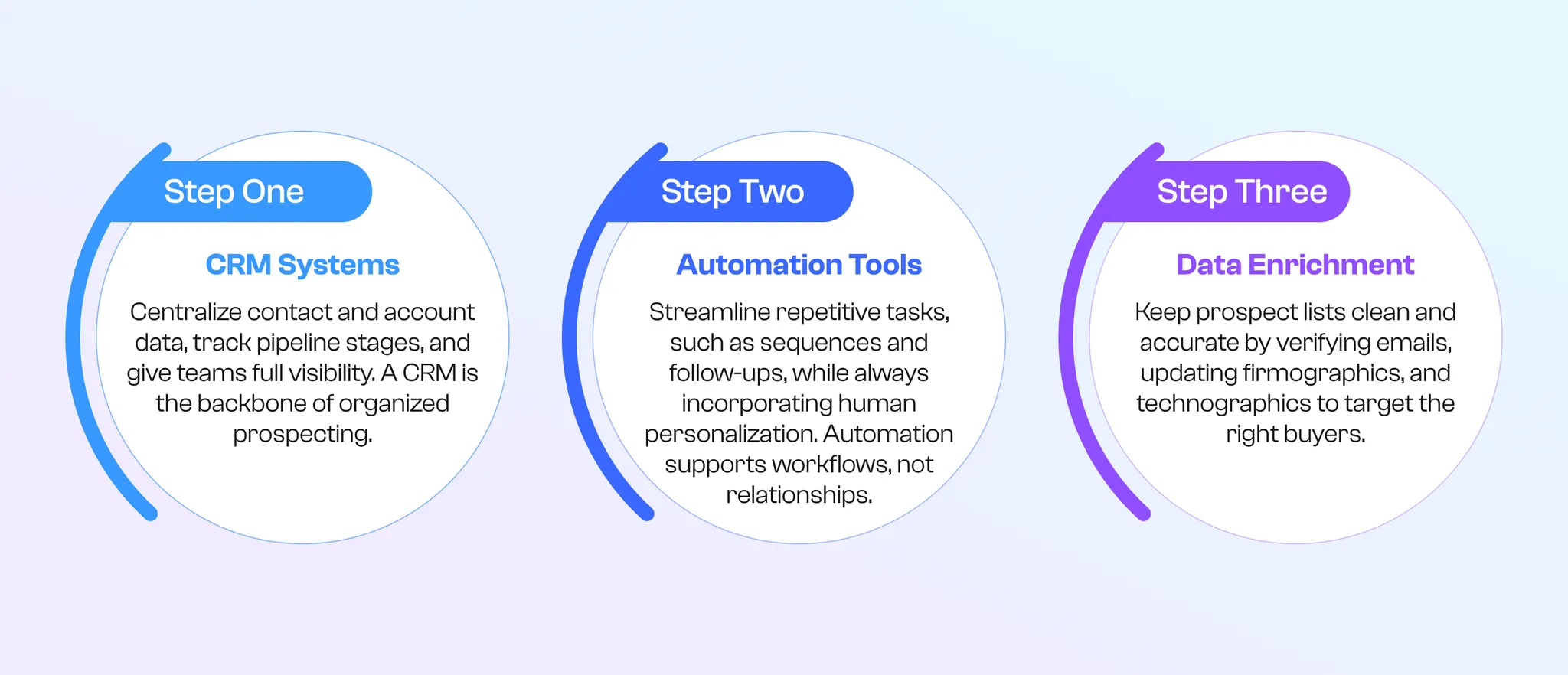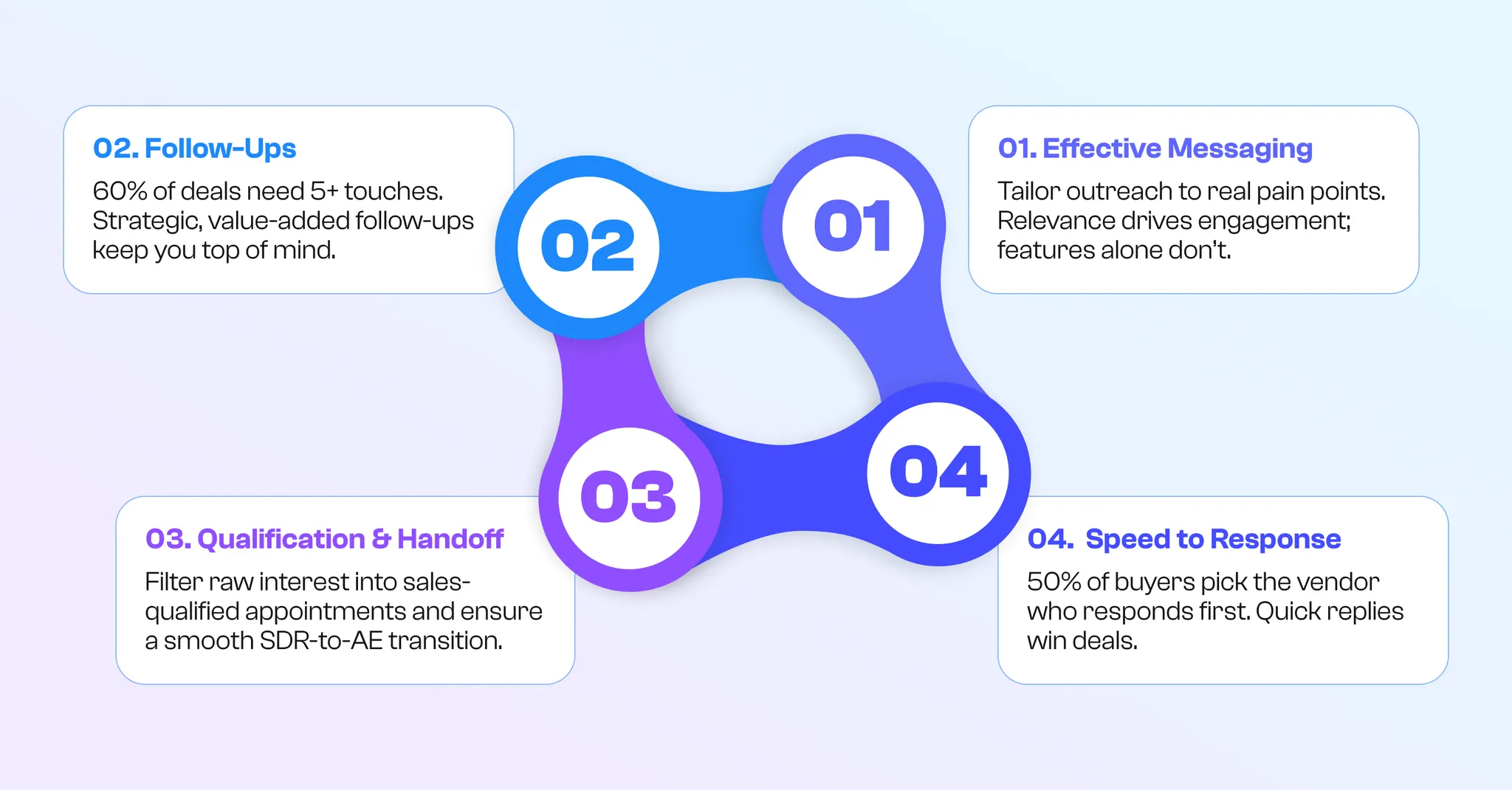Sales prospecting in B2B is a systematic process that involves identifying, engaging, and converting potential customers into real opportunities. It’s the front line of sales, where the first spark of interest either turns into a conversation or fades out.
Why does it matter so much? Because without consistent prospecting, your pipeline dries up, meetings disappear, and revenue slows to a crawl. Prospecting is what keeps business growth alive.
And here’s a quick clarification: prospecting isn’t the same as lead generation. Lead generation is about attracting interest: think content marketing, PPC campaigns, or inbound traffic. Prospecting, on the other hand, is an active outreach strategy — your sales team identifies prospects, initiates conversations, and moves them closer to conversion.
Why Sales Prospecting Is Critical
Every salesperson knows this truth: prospecting is tough. According to HubSpot, 40% of salespeople report that prospecting is the most challenging part of their job. But it’s also the most crucial. Without it, opportunities never progress from awareness to meetings, and your pipeline remains stagnant at the top.
From my perspective at SalesAR, structured prospecting is what turns chaotic results into predictable outcomes. Random outreach leads to random replies. However, when you break it down into a system, you suddenly see patterns. Replies increase. Meetings get booked. And revenue doesn’t feel like a gamble anymore.
Our team helps companies build repeatable processes that consistently turn cold outreach into real opportunities.
Building the Foundation
Too many sales teams rush into outreach without first laying the groundwork. They buy a list, send a few hundred emails, and then wonder why the results don’t align with their goals. That’s because successful B2B sales prospecting doesn’t start with messaging. It begins with clarity. Clarity about who you’re selling to, why they should care, and whether they even fit your solution in the first place. Without clear sales prospecting strategies, every campaign becomes a guessing game.

Start with the Ideal Customer Profile (ICP)
Think of the ICP as your compass. It guides every step of prospecting and keeps you from wasting time on companies that will never buy from you. An ICP should go deeper than “mid-sized SaaS firms in North America.” You want to layer in:
- Firmographics: Company size, revenue, location, and industry verticals. Selling to a 50-person IT consultancy is different from selling to a 5,000-person enterprise.
- Technographics: What technology stack are they using? A prospect already using Salesforce might respond better to a CRM integration pitch, while one stuck on spreadsheets needs a different hook.
- Intent signals: Are they researching topics related to your solution? Visiting competitor websites? Posting jobs that hint at upcoming needs? These signals help you catch prospects at the right moment.
SalesAR Insight: Сompanies that define their ICP clearly achieve 68% higher win rates compared to those that don’t. Why? Instead of chasing everyone, they double down on accounts where the odds are stacked in their favor.
Buyer Personas Make Outreach Personal
If the ICP defines the “who,” buyer personas define the “how.” Every deal involves people, and people have different motivations. The pain points of a CTO aren’t the same as those of a CFO or Head of Sales.
- The CTO is focused on integrations, security, and scalability. They want to know if your solution is technically sound and future-proof.
- The CFO is looking at budgets and ROI. Their question is simple: “Does this save us money or generate more of it?”
- The Head of Sales is committed to team performance and achieving targets. They need to know if your product makes closing deals faster and easier.
When you align your messaging to these personas, you stop sending generic pitches and start speaking their language. And that’s when replies shift from “Not interested” to “Let’s schedule a call.”
The Payoff of Building the Foundation
When you combine ICP, buyer personas, and TAM, you create a sales prospecting framework that provides direction for your outreach. You’re not sending random cold emails — you’re running a targeted process. And here’s the real payoff: prospects notice. They can distinguish between a generic pitch blasted to thousands and a tailored message that reflects their industry, role, and current challenges.
From experience, I can say this upfront work pays off faster than you think. Outreach campaigns with a clear ICP and well-built personas generate higher reply rates, faster conversions, and stronger long-term client relationships. In fact, focusing on a defined ICP often reduces wasted touches by up to 30%, saving both time and budget.
Ultimately, effective sales prospecting is about relevance. And relevance begins with building a solid foundation before you send a single email.
Inbound vs. Outbound Sales Prospecting
When it comes to sales prospecting, you’ll hear two terms thrown around all the time: inbound and outbound. Both matter, but they serve different purposes, and the best teams know how to strike a balance between them.
Inbound prospecting is when prospects come to you. They’ve found your content, discovered you through SEO, clicked on your ads, or engaged with you at an event. These leads are often warmer and further along in the buying journey.

No surprise, then, that inbound leads are more likely to convert compared to outbound leads. But the flip side? Inbound takes time. You need months (sometimes years) of consistent content, optimized search presence, and brand-building before you see that steady stream of prospects.
Outbound prospecting, on the other hand, is about making the first move. Cold emails, LinkedIn messages, phone calls — this is where you directly reach out to your ICP and start the conversation yourself.
Outbound works exceptionally well when you’re entering new markets or testing new verticals, because you don’t have to wait for prospects to find you. It delivers faster initial traction, and with a structured process, it fills pipelines quickly.
The real growth comes from combining them. Inbound builds long-term scalability, while outbound ensures you don’t wait around for leads to show up. One nurtures authority; the other drives speed. Together, they create a steady flow of opportunities that keep your pipeline healthy today and sustainable tomorrow.
Core Sales Prospecting Techniques
Once the foundation is set, you need the right techniques to reach prospects in a way that sparks real conversations. Generic blasts don’t work anymore. Buyers are bombarded with pitches daily, so your outreach must stand out from the crowd.

Personalized Email Outreach
Email is still the backbone of prospecting, but personalization makes or breaks it.
- Use relevance: Mention industry trends, their tech stack, or a recent company update.
- Subject lines matter: Personalized subject lines increase open rates by 26%.
- Go beyond templates: Funding news, job postings, or shared connections can trigger replies.
When prospects see you’ve tailored the email to them, you move from the spam folder to “worth responding to.”
Social Selling on LinkedIn
LinkedIn is where business credibility lives, and social selling keeps you top of mind.
- Engage with posts: Comment thoughtfully, not generically.
- Build authority: Share insights that align with your ICP’s challenges.
- Stay visible: Buyers prefer to work with people they recognize; 78% of social sellers outperform peers who don’t leverage social media.
Multi-Channel Touchpoints
One touchpoint is easy to ignore. Multiple touchpoints create familiarity.
- Email + LinkedIn + calls: This mix drives a 30% higher response rate than single-channel outreach.
- Respect preferences: Some people hate calls, others never check LinkedIn. Covering channels ensures you meet them where they are.
- Consistency counts: Structured cadences (e.g., 6–8 touches over 2 weeks) outperform one-off efforts.
Intent Data & Tracking
Why chase cold leads when you can spot who’s already “heating up”?
- Monitor signals, including job ads, competitor tool usage, and content downloads.
- Prioritize efforts: Companies using intent data achieve up to 4 times better conversion rates (Demand Gen Report).
- Strike early: Reach out while they’re still researching before competitors do.
This is how you uncover hidden demand before it shows up in inbound form.
Referrals & Networking
Old-school, but still one of the fastest paths to a deal.
- Referrals shorten cycles: 92% of buyers trust referrals from people they know.
- Make it routine: After a closed deal, ask for introductions to key contacts.
- Tap your network: Partners, colleagues, and industry peers often open doors faster than cold emails.
Used together, these techniques turn cold outreach into meaningful engagement, and that’s when pipelines stop looking random and start looking predictable.
We specialize in running the outreach playbook at scale, combining personalization, multi-channel cadences, and data-driven targeting to deliver measurable results.
Technology & Sales Prospecting Tools
Prospecting today involves using the right sales prospecting tools to stay efficient and consistent. The sales stack continues to grow, but not every new platform adds value. The real win comes from choosing technology that supports your strategy without turning your outreach into robotic noise.

CRM Systems
A customer relationship management (CRM) platform is the backbone of modern prospecting. It keeps all account and contact data in one place, tracks conversations, and shows precisely where prospects sit in the pipeline. Without it, sales teams end up working in silos, duplicating efforts, or letting warm opportunities slip through the cracks. A good CRM isn’t just for recordkeeping; it’s your command center for managing follow-ups, measuring activity, and forecasting revenue.
- Centralizes contact and account data
- Tracks pipeline stages and opportunities
- Provides visibility across the whole sales team
Automation Tools
Outreach automation tools can save hours of manual work by automating repetitive tasks, such as sending sequences, scheduling follow-ups, or syncing data. But here’s the catch: automation is only as good as the personalization you layer on top. No decision-maker wants to feel like they’re email #237 in a sequence. Teams that balance automation with human input see far higher engagement.
- Automate workflows, not relationships
- Use templates as a framework, then personalize at scale
- Bad setups lead straight to spam
Data Enrichment
Even the best message fails if it goes to the wrong person. That’s why data enrichment is critical. Tools that validate and enhance prospect data help ensure your lists are accurate, complete, and current. Whether it’s confirming job titles, filling in missing firmographics, or checking active emails, enrichment keeps your outreach targeted and credible.
- Clean and verify email addresses to reduce bounce rates
- Add technographics and firmographics for better targeting
- Refresh lists regularly to avoid outdated data
SalesAR Insight: Technology should enhance strategy, not replace it. A CRM without a clear ICP is just a database. Automation without relevance is spam. And enrichment without strong messaging won’t win replies. The best prospecting results come from combining the right tools with a thoughtful, human-driven process.
From Outreach to Conversion
Reaching a prospect is only the first step. The real test begins once they respond. At this stage, messaging, persistence, and process determine whether the conversation advances into a booked meeting or disappears into silence.

Effective Messaging
Outreach that connects directly to pain points resonates far more than a generic value statement. The key is to tailor your message so it feels like you understand their challenges better than anyone else. When the pain point is clear, the reply feels natural. Relevance drives engagement; features alone don’t.
Follow-Ups Make the Difference
One of the biggest mistakes in prospecting is stopping after a single unanswered email.
SalesAR Insight: Research indicates that 60% of deals require five or more follow-ups before being closed. Consistent, polite persistence shows commitment and keeps you top of mind.
Often, the difference between a lost opportunity and a booked meeting is simply the extra two or three touches that competitors didn’t bother to send.
- Space follow-ups strategically to avoid overwhelming.
- Add value in each message (insights, case studies, relevant resources).
- Email, LinkedIn, and calls work better together than individually.
Qualifying Leads & Smooth Handoffs
Not every reply means a deal. That’s why qualification matters: converting raw interest into sales-qualified appointments ensures your Account Executives (AEs) spend their time where it counts. SDRs should clarify need, budget, authority, and timing before handing leads over. From there, a seamless SDR-to-AE handoff prevents miscommunication and fosters trust with the buyer.
- Define clear qualification criteria with your sales team.
- Share detailed notes so that the AE can continue naturally from the SDR’s work.
- Maintain accountability between both roles.
Speed Is a Deal Maker
Timing plays a massive role. According to InsideSales, 50% of buyers choose the vendor who responds first. That means the team that replies quickly, confirms availability, and books the meeting often wins before the competition even has a chance to answer.
Metrics That Matter
Prospecting without measurement is like running blind: you might feel busy, but you won’t know if it’s paying off. Tracking the right metrics keeps teams accountable and shows which activities genuinely push the pipeline forward.
Outreach metrics indicate how effectively your initial contacts are being received.
The most telling metric is the number of sales-qualified appointments. When a lead meets your ICP criteria, shows intent, and agrees to a meeting, you have the most evident proof that prospecting in sales is driving ROI. It’s the point where activity translates into measurable business value.
We’ll help you fuel your funnel with appointments that matter: sales-ready opportunities that shorten the path from first touch to closed deal.
Common Mistakes to Avoid
Even experienced teams fall into traps that slow progress or kill results. The good news? Most of these mistakes are preventable once you know what to watch for.
- Over-reliance on generic templates. Prospects ignore cookie-cutter outreach. Relevance always beats volume.
- Prioritizing volume over quality. Sending thousands of emails to the wrong accounts wastes time and damages the domain’s reputation.
- Inconsistent follow-ups. One email isn’t enough. With 60% of deals needing 5+ touches, dropping the ball early leaves money on the table.
- Ignoring inbound opportunities. Outbound fills the pipeline fast, but if you neglect warm inbound leads, you’re missing the easiest conversions.
SalesAR Insight: Precision, persistence, and personalization consistently win over brute force. A smaller, well-targeted campaign with consistent follow-ups will consistently outperform a massive blast.
Conclusion
When B2B teams commit to the fundamentals, they stop chasing randomness and start building pipelines they can count on. Consistency replaces guesswork, and opportunities stop slipping through the cracks.
Success in prospecting isn’t about sending more messages. It’s about creating more meaningful conversations that foster trust, uncover genuine needs, and lay the groundwork for lasting partnerships.


